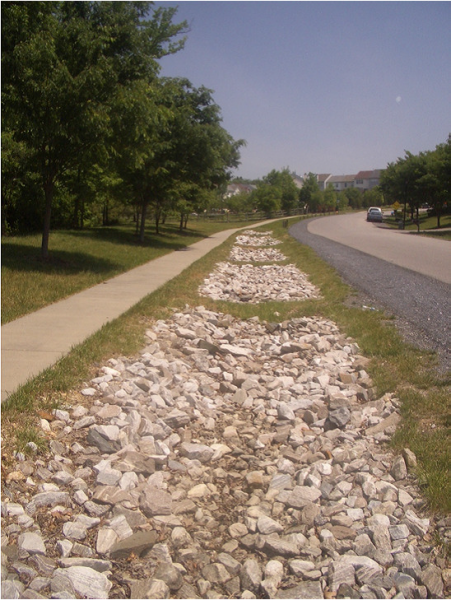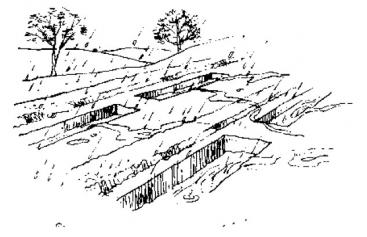Infiltration trenches are shallow excavations filled with rubble or stone. They allow water to infiltrate into the surrounding soils from the bottom and sides of the trench, enhancing the natural ability of the soil to drain water. Ideally they should receive lateral inflow from an adjacent impermeable surface, but point source inflows may be acceptable with some design adaptation (effectively they are a form of soakaway).
Infiltration trenches reduce runoff rates and volumes and can help replenish groundwater and preserve base flow in rivers. They treat runoff by filtration through the substrate in the trench and subsequently through soil. They are effective at removing pollutants and sediment through physical filtration, adsorption onto the material in the trench, or biochemical reactions in the fill or soil. However they are not intended to function as sediment traps and must always be designed with an effective pre-treatment system where sediment loading is high (e.g. filter strip). Unless very effective pre-treatment is included in the design, they are best located adjacent to impermeable surfaces such as car parks or roads/highways where there levels of particulates in the runoff are low. They work best as part of a larger sustainable drainage treatment train. Infiltration trenches are easy to integrate into a site and can be used for draining residential and non-residential runoff. Due to their narrow shape, they can be adapted to different sites, and can be easily retrofitted into the margin, perimeter or other unused areas of developed sites. Infiltration trenches are also ideal for use around playing fields, recreational areas or public open space. They can be effectively incorporated into the landscape and designed to require minimal land take.
 |
 |
|
Infiltration trenches with stones in urban area Source: Andras Kis’ presentation, NWRM Workshop 1 |
Infiltration trenches in agriculture area Source: UNDP 2008 (http://www.sswm.info/category/implementation-tools/water-sources/hardware/precipitation-harvesting/field-trenches) |
| Benefits | Level |
|---|---|
|
ES1 - Water storage
|
Low
|
|
ES5 - Climate change adaptation and mitigation
|
Low
|
|
ES6 - Groundwater/aquifer recharge
|
High
|
|
ES7 - Flood risk reduction
|
High
|
|
ES8 - Erosion/sediment control
|
Low
|
|
ES9 - Filtration of pollutants
|
Medium
|
|
ES11 - Aesthetic/cultural value
|
Low
|
|
PO2 - Improving status of physico-chemical quality elements
|
Low
|
|
PO4 - Improving chemical status and priority substances
|
Low
|
|
PO5 - Improving quantitative status
|
Medium
|
|
PO7 - Prevent surface water status deterioration
|
Low
|
|
PO8 - Prevent groundwater status deterioration
|
Low
|
|
PO9 - Take adequate and co-ordinated measures to reduce flood risks
|
High
|
|
PO11 - Better protection for ecosystems and more use of Green Infrastructure
|
Low
|
|
PO12 - More sustainable agriculture and forestry
|
Low
|
|
BP1 - Store runoff
|
Medium
|
|
BP2 - Slow runoff
|
Low
|
|
BP6 - Increase infiltration and/or groundwater recharge
|
High
|
|
BP7 - Increase soil water retention
|
Low
|
|
BP9 - Intercept pollution pathways
|
Medium
|
|
BP10 - Reduce erosion and/or sediment delivery
|
Medium
|
